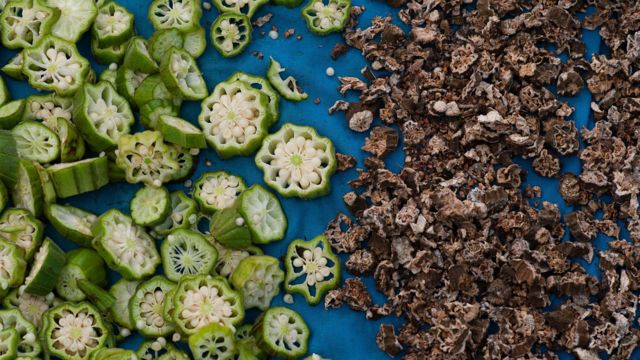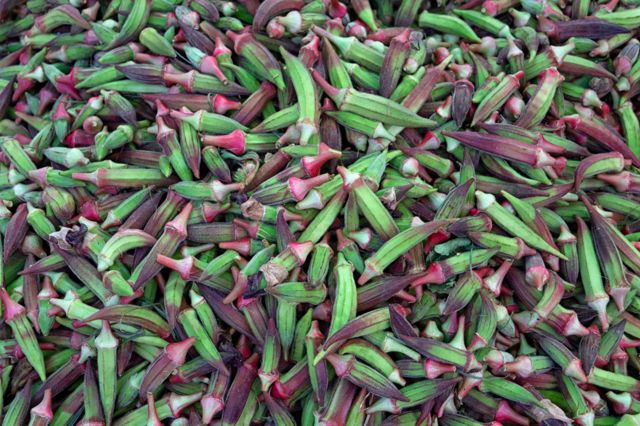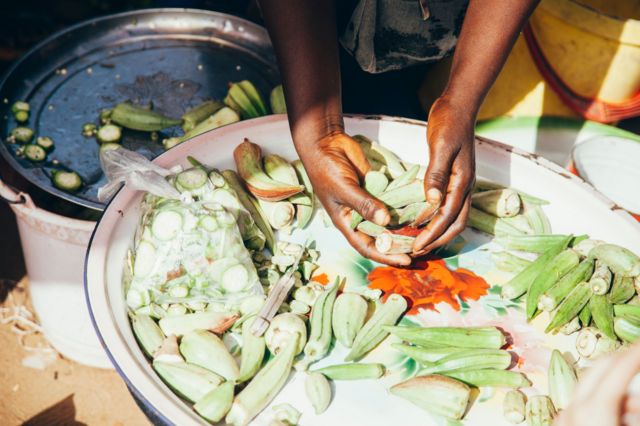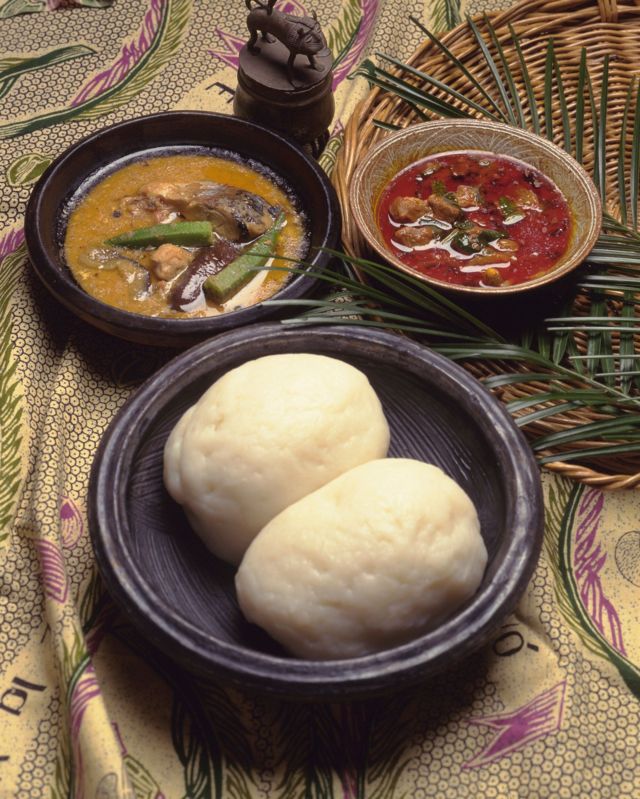
Wia dis foto come from, Getty Images
Okro na very popular plant for West Africa.
Pipoo dey cook am and also use am for medicinal purposes. Inside dis article, we go chook eye for di health benefits of dis highly prized African vegetable.
If you waka about for one West African market, you dey almost sure to find okro for stalls. Although originally from Africa, okro, im scientific name na Abelmoschus esculentus, dey grow for almost evri kontinent.
Although e dey associated wit some food for West and Central Africa, India na di world leading producer, dey produce 6,126,000 tonnes per year.
Followed by Nigeria, wey dey produce 2,033,129 tonnes per year. Sudan complete di list of di world biggest okro producers, wit annual output of 304,712 tonnes.
Wetin be okro?
Okro na one plant wey dem dey chop im fruit as vegetable, particularly for Africa.
Dis fruiting vegetable dey come for different varieties, depending on di region. Dey get different size, leaves, flowers, fruit and seeds.
E get, for example, short-stem and tall-stem varieties. Short-stem varieties get short life cycle, wit fruit wey go ripe afta three months, while tall-stem varieties get longer life cycle, wey dey last from six to nine months.
Okro fruits also get different colour, from green to red.
Di size of di fruit fit also get different factors to sabi dem. Fruits fit measure between 5 and 20 cm.
As well as size, di seeds wey dey each fruit different according to variety.

Wia dis foto come from, Getty Images
Nutritional benefits of okro
“Okro dey rich in vitamins and minerals. E contain vitamins from di B group, especially B2, B3, B6 and B9, as well as vitamin C. E also rich wit vitamin K,” nutritionist Mamadou Seydou Bah, President of di NutriMali association explain.
Okro pods na good source of nutrients and antioxidants like vitamin C, polyphenols, polysaccharides and minerals, according to one 2018 study by Yuan et al.
Antioxidants, as dia name suggest, “fight against wetin dey known as oxidation of cells for di human bodi, wey free radicals dey cause”, Bah explain.
According to Ivorian nutritionist Marion Ezzedine, okro high vitamin C content make am food wey dey boost di immune system and help combat cell ageing.
If you dey look to lose weight, you fit consider okro as ally. Im low fat content mean say e get low calorie intake.
Okro also dey play one important role for di digestive process, thanks to di dietary fibre wey e contain.

Wia dis foto come from, Getty Images
“So na food wey dey help regulate intestinal transit and blood cholesterol levels,” Ms Ezzedine reveal.
Dietary fibre also dey help to slow how carbohydrates and fats dey enta body.
According to Dr Mamadou Seydou Bah, okro na plant wey dey very rich for manganese and magnesium.
“Manganese dey play one important role for bone mineralisation, as well as for protein metabolism. E also get hand for how di nervous system dey function”, Oga Bah tok.
As well as im nutritional value, okro also dey used inside traditional medicine.
“Okro dey used a lot, especially for di treatment of nodules inside traditional medicine,”Mamadou Seydou Bah tok.
“One series of bioactive compounds like flavonoids and catechins don dey discovered inside okro plant, e associate wit plenti biological properties wey research studies observe say report potential anti-diabetic, anti-cancer, anti-hypertensive and antimicrobial effects, among odas, sake of dia consumption,” e dey one scientific article by Agregan et al.

Wia dis foto come from, Getty Images
How you dey use okro to enjoy im benefits?
Very popular for West and Central Africa, okro dey associated wit different dishes wey pipo dey chop for dis part of Africa.
Depending on di dish, okro fit dey boiled, chop am raw for dried salads or even use am as additive inside soups.
For Nigeria, pipo dey dey use am cook soup. E also get pipo wey dey boil am or soak am for water – for pipo wey dey use am for medicine.
For Senegal, dem dey use am cook soupou kandja, while for Côte d’Ivoire dem dey use am prepare gombo sauce. E get many different versions of gumbo sauce for different kontries, so no dey surprised if you hear of Cameroonian or Beninese version.
For di Republic of Guinea, okro na one of di ingredients wey dem dey use prepare foutti, one dish from sorrel leaves and okro.
According to Dr Ezzedine, “e go dey more digestible if e dey cooked, but di nutrients dey better preserved wen okro dey raw (particularly vitamin C, wey dey sensitive to heat)”.
Nutritionist Mamadou Seydou Bah also advise against to boil okra too much to avoid fall for some vitamins. E also advise pipo wey prefer dried okro make dem no leave am too long inside sun.
“Okro get slimy texture wey dey thicken sauces. To reduce di slimy aspect, simply eat am raw or lightly wash out”, nutritionist Ezzedine add.